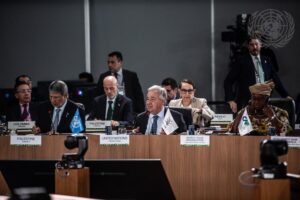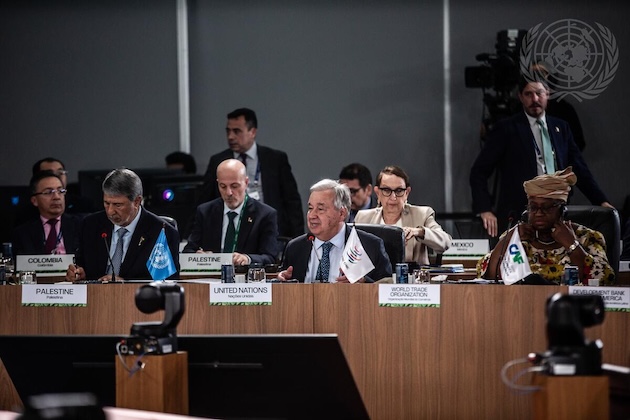
Active Citizens, Arts, Biodiversity, Climate Change, Editors’ Choice, Environment, Global, Headlines, Latin America & the Caribbean, Natural Resources, TerraViva United Nations

“Plastic Ocean” by Alejandro Duràn, one of the artworks previously on display in the UN lobby. Credit: Jennifer Levine/IPS
– The United Nations’ HOMO SARGASSUM exhibition served as a public immersion into the marine world and called upon viewers to take action in the face of the climate crisis, specifically regarding invasive species and water pollution.
For the past month, an art exhibition entitled HOMO SARGASSUM took up residence in the New York headquarters lobby in connection to World Ocean Month and the 2025 UN Ocean Conference. Organized by the Tout-Monde Art Foundation. In its final week on display, visitors walked through the various projected films, sculptures and photographs. The exhibit closed on July 11.
The work is described as an immersive multisensorial art and science exhibition intended to bring together various experts in science, scholarship and creativity from the Caribbean to share their perspectives on the prevalent environmental and social issue. The exhibit is primarily an introspective study of sargassum, a type of seaweed or algae commonly found on the coast of the Americas and in the Caribbean.
Sargassum, which has proliferated significantly in recent years due to pollution and chemical fertilizer, releases toxic gases that harm nearby residents in water and on land. Animals struggle to survive, and humans experience respiratory failures and burns. This algae has inspired fear since Christopher Columbus recorded his crew’s sighting of the plant. Sargassum has also become a symbol recently for climate change in the Caribbean as well as the coexisting nature of marine and human life.
Co-curator and executive and artistic director of the Tout-Monde Art Foundation Vanessa Selk described the exhibit as a journey rather than a singular experience. She said, “Much like sargassum migrating through the Atlantic Ocean, we encounter natural and human-made challenges such as pandemics, pollutants and hurricanes. This narrative of the global ecological crisis, reflected in silent floating algae, warns us to change our existing paradigms and consider ourselves as one with our environment.”
Billy Gerard Frank, one of the featured artists in HOMO SARGASSUM, echoes this sentiment.
Frank created a mixed-media piece entitled “Poetics of Relation and Entanglement” with a painting featuring Columbus’ archival notes and sargassum pigment, as well as a film he shot on the island of Carriacou. The film centered on a large metal tank surrounded by sargassum, which had washed on shore and rusted onto the massive object. He specifically shot the film around the sargassum and the tank, an eyesore for the locals who used the beach and a barrier to boats trying to leave. Growing up in Grenada, Frank recalls sargassum as a mild inconvenience but explained how it has become more prevalent due to climate change.
However, only in recent years has conversation around sargassum shifted towards the impact of climate change and geographical inequities, like, as Frank noted, how smaller islands that produce significantly lower levels of pollution are the worst affected by climate change through natural disasters.
He referenced the recent Hurricane Beryl, a Category 5 storm that “completely devastated” islands like Carriacou. His inclusion of Columbus’ notes brings a decolonial perspective: the threats Caribbean islands face from mounting climate change are exacerbated by their history of occupation, mostly from European colonial powers. In a global organization like the UN where historical, geographical and environmental context is key to making any decision, such an interdisciplinary perspective is key.
From countless gifts from member states to various donations, the UN has been an artistic hub since its inception. As both a tourist attraction and space of work for international diplomats, the UN is a particularly ripe space for more radical, political art—notably Guernica, a tapestry based on a Picasso painting portraying the Spanish Civil War—due to its broad audience.
Speaking to IPS, Frank shared how influential art has been in political, social and intellectual movements, saying, “historically…creators, writers, and artists have been able to forge ahead and create new spaces…it gives us some hope that our work and the calling are even more important.”
Frank also told IPS how important it was for him to have the work featured at the UN.
“Because the UN is also a site of consternation right now, specifically with everything that’s happening globally. And in fact, that’s the space where this type of work should be, where there should be more conversation, and a space in which it could create a critical dialogue amongst people who work there, but also the public facing that too.”
IPS UN Bureau Report


